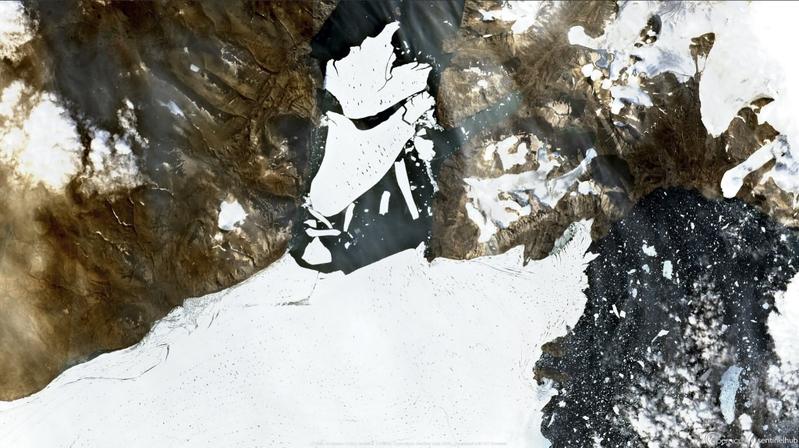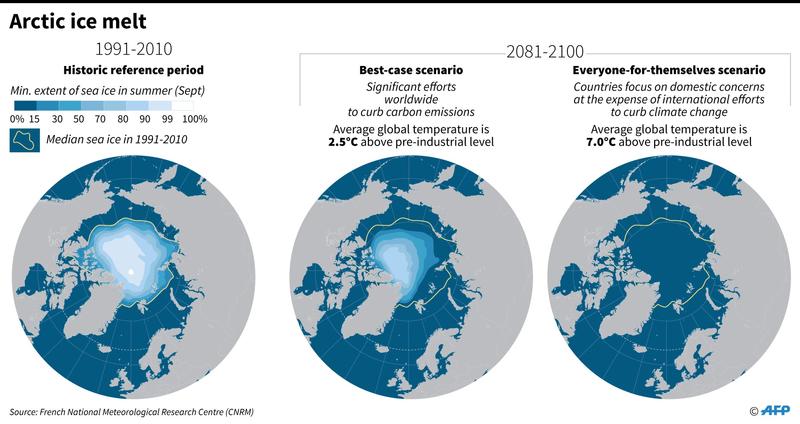 This handout satellite image captured on Aug 27, 2020 by the Copernicus Sentinel-2 mission and released by European Space Agency (ESA) shows ice breaking off the Nioghalvfjerdsfjorden glacier in Northeast Greenland. (PHOTO / EUROPEAN SPACE AGENCY / AFP)
This handout satellite image captured on Aug 27, 2020 by the Copernicus Sentinel-2 mission and released by European Space Agency (ESA) shows ice breaking off the Nioghalvfjerdsfjorden glacier in Northeast Greenland. (PHOTO / EUROPEAN SPACE AGENCY / AFP)
ARCTIC OCEAN - At the edge of the ice blanketing part of the Arctic Ocean, the ice on Monday looked sickly. Where thick sheets of ice once sat atop the water, now a layer of soft, spongey slush slid and bobbed atop the waves.
Not so long ago, I heard that we had 100 years before the Arctic would be ice free in the summer. Then I heard 75 years, 25 years, and just recently I heard 15 years. It’s accelerating.
Paul Ruzycki, researcher
From the deck of a research ship under a bright, clear sky, “ice pilot” Paul Ruzycki mused over how quickly the region was changing since he began helping ships spot and navigate between icebergs in 1996.
“Not so long ago, I heard that we had 100 years before the Arctic would be ice free in the summer,” he said. “Then I heard 75 years, 25 years, and just recently I heard 15 years. It’s accelerating.”
As if on cue, scientists on Monday said the vast and ancient ice sheet sitting atop Greenland had sloughed off a 113 square kilometer chunk of ice last month. The section of the Spalte Glacier at the northwest corner of the Arctic island had been cracking for several years before finally breaking free on Aug 27, clearing the way inland ice loss to the sea, the Geological Survey of Denmark and Greenland reported.
 A picture taken on Aug 17, 2019 shows an iceberg calving with a mass of ice breaking away from the Apusiajik glacier, near Kulusuk (aslo spelled Qulusuk), a settlement in the Sermersooq municipality located on the island of the same name on the southeastern shore of Greenland. (JONATHAN NACKSTRAND / AFP)
A picture taken on Aug 17, 2019 shows an iceberg calving with a mass of ice breaking away from the Apusiajik glacier, near Kulusuk (aslo spelled Qulusuk), a settlement in the Sermersooq municipality located on the island of the same name on the southeastern shore of Greenland. (JONATHAN NACKSTRAND / AFP)
With climate change driving up Arctic temperatures, the once-solid sea ice cover has been shrinking to stark, new lows in recent years. This year’s minimum, still a few days from being declared, is expected to be the second-lowest expanse in four decades of record-keeping. The record low of 3.41 million square kilometers – reached in September 2012 after a late-season cyclonic storm broke up the remaining ice – is not much below what we see today.
“We haven’t gone back at all to anything from 30 to 40 years ago,” said climatologist Julienne Stroeve at the National Snow and Ice Data Center in Boulder, Colorado. And as climate change continues, scientists say the sea ice is unlikely to recover to past levels.
ALSO READ: Record Greenland ice loss poses threat to coastal cities worldwide
In fact, the long-frozen region is already shifting to an entirely new climate regime, marked by the escalating trends in ice melt, temperature rise and rainfall days, according to new research published Monday in the journal Nature Climate Change.
Those findings, climate scientist Laura Landrum said, were “unnerving.”
All three variables – sea ice, temperatures and rainfall – are now being measured well beyond the range of past observations. That makes the future of the Arctic more of a mystery.
“The new climate can’t be predicted by the previous climate,” Landrum explained. “The year-to-year variability, the change in many of these parameters, is moving outside the bounds of past fluctuations.”
Sea ice coverage minimums, in particular, are now about 31 percent lower than in the decade after 1979, when satellite observations began. The ice has also lost about two-thirds of its bulk, as much of the thicker ice layer built up over years has long since melted away. The current ice regime actually began about two decades ago, the study found.

This vanishing of sea ice also contributes to the region’s warming, as the icy white expanse is replaced by patches of dark water that absorb solar radiation rather than reflecting it back out of the atmosphere. The process, referred to as Arctic amplification, helps to explain why the Arctic has warmed more than twice as fast as the rest of the world over the last four decades.
The polar north will also likely see more days of rain rather than snow, which would further eat into the ice. For the new research, Landrum and her colleague Marika Holland at the National Center for Atmospheric Research analyzed sea ice, air temperature and precipitation data since 1950 to project climate scenarios up to the end of the century. They used computer simulations in the analysis and assumed the world’s release of greenhouse gas emissions would continue at a high trajectory.
READ MORE: Worst-ever Arctic fires released record amount of CO2
Back in the Arctic Ocean aboard the Greenpeace Ship Arctic Sunrise research ship, biologist Kirsten Thompson of the University of Exeter said the new study was important in underlining “how fast and how profoundly the Arctic is changing.”
For Thompson, that means big change for the region’s wildlife, from polar bears and insects to the whales she focuses on studying. “All their distributions are changing,” Thompson said. “We might find in the Arctic there will be winners and losers,” as new species enter the region and outcompete indigenous animals.
“Other species certainly will not be able to survive in the future.”


